
- Place order

Can a single Paragraph Constitute an Essay? – Tips for One-Paragraph Essays

An essay can be one paragraph if you are asked to write a concise essay with one main idea, which is between 100 to 200 words or 10 to 14 sentences. In most cases, this is categorized as a short essay. It is an essay that bears a single argument and respective supporting ideas or pieces of evidence. As long as your single-paragraph essay can make sense to your readers, it can fetch you good marks.
Usually, these short-paragraph essays are assigned during exams, quizzes, and in-class tests. Your aim when writing such essays is to analyze a topic to help your readers understand it better and draw conclusions. You can also be assigned to write single-paragraph essays in response to specific chapter readings, respond to a discussion board post, or when analyzing a short story.
Whatever the circumstances, you should not be worried about where to start. As long as you know how to write a good paragraph and organize an essay , you are good to go.
What is One-Paragraph Essay?
A one-paragraph essay, also known as a single-paragraph essay or the chunk paragraph, is a concise and boiled-down version of a full academic essay. It comprises a formal thesis statement at the beginning, concrete details and commentary in the middle, and a concluding statement at the end.
A one-paragraph essay has the same essence as the body paragraph of an essay that has a mini-thesis statement, supporting details, and a concluding sentence at the end.
When writing your one-paragraph essay, you should cut out the general information that sets up the introduction and avoid restating the thesis or including the implications in the concluding sentences (acting for the concluding paragraph).
The 5 Key Components of a Single Paragraph Essay
The five main components of a single-paragraph essay include the thesis statement, body point, concrete details, commentaries, and a concluding sentence. Let’s expound on each so that you can understand.
- Thesis Statement: begin writing your essay with a thesis statement that contains your position. It should be a declarative sentence summarizing your essay's main point. In a one-paragraph essay, the thesis serves as the topic sentence . Given that the essay is only a paragraph long, the thesis statement assumes the role of announcing the contents of the paragraph. The thesis statement should also have a position on the topic that can be proven in the paragraph. Finally, support the narrow topic with concrete details and a commentary.
- Body Point. This refers to the second sentence in your single-paragraph essay where you make an important point that directly proves the thesis. It should direct the attention of the readers to a specific piece of evidence used in the concrete detail.
- Concrete detail. This refers to a specific example from the references or resources to support the thesis. It can be a summary, paraphrased content, quotation, or a statement from the reference and should be cited (provide the parenthetical details).
- This refers to the explanation or interpretation of the concrete detail. This is a sentence or two sentences where you explain, using your own words, the meaning of the examples you have given and how it proves or support the thesis.
- Concluding sentence. This is the last sentence of the one-paragraph essay that wraps up the paragraph. Even though it is directly related to the thesis, it does not repeat it. Rather, it is the sentence that drives the point home without leaving the readers with the question of “so what?”. Like a typical conclusion paragraph, it should be devoid of new ideas or facts. Instead, it should tie up loose ends and offer some sense of closure to your essay.
A typical one-paragraph essay can have at least two concrete details and two commentaries, meaning it can be 10-14 sentences long, depending on your concrete details. If you are strapped for time, your concise essay can consist of 125–200 words.
How do you write a one-paragraph essay? The Steps
Even if it is a one-paragraph essay, it comprises several sentences, as we have explored above. So, when you are assigned a single-paragraph essay, you need to plan and write a better essay that will tick all the checkboxes used when marking.
Unlike traditional essays that probably take time, a single-paragraph essay will take you under an hour to write. Also, single-paragraph essays do not have body paragraphs . Sometimes it is a short-paragraph answer in an exam where you provide specific details that answer a given question. It can also be a short paragraph for a profile essay task or a short narrative essay.
Whichever the case, to succeed in writing the one-paragraph essay, follow the steps below.
1. Unpack the question
Begin by reading the essay prompt or the question to understand the scope of the essay, topic, word count (length requirements), and other specifics of the short essay assignment. Then, as you read, make quick notes and brainstorm to develop a perspective.
2. Develop an angle or perspective
After understanding your assignment, your next step is to develop the gist of your essay's main point/idea. It should be your take on a chosen subject or topic. For example, you can write about issues around you or current events, controversies, and other topic areas that interest you. However, if you are given a topic or the question is specific, stick to a perspective that better answers the question.
3. Write the thesis statement
With the perspective, write a declarative statement that summarizes your main idea or angle. The thesis should be one sentence long, brief, concise, and relatable. The thesis should be the first sentence of your essay and be strong enough to be substantiated in the body paragraphs. The thesis should be able to be proved, should not be self-evident, and must be able to be argued from another angle. Everything in the essay ties back to the thesis.
4. Write the body point
Immediately follow the thesis with a sentence that asserts the main idea or the thesis. The body point should prove and support the thesis statement. It is a statement that can be both opinion and fact backed with specific examples (concrete details) and clarified through further development and explanation (commentaries). Together, the body points, concrete details, and commentaries form a chunk.
5. Write the concrete details
Provide two examples, points, or pieces of evidence that support the assertions made in the body point. You should not begin it with a quote. Rather, ensure that you blend or introduce it and include the relevant citations.
6. Write the commentaries
Expand or expound on the specific examples provided and connect them to your thesis statement and body point (BP). You can repeat the process because a typical one-page essay can have at least two or three concrete details (CD) and the respective commentaries (CM). Ensure that the CM and CD relate to the topic, the thesis, and BP.
7. Finalize with a concluding sentence
Finally, wind up everything when you have exhaustively covered the main point and you are sure that your single-essay paragraph makes sense. Your concluding sentence is the last sentence. It should restate the thesis and summarize the body.
8. Edit, proofread, and polish
After completing the paragraph, read it to yourself and listen to the areas where you might have made mistakes. If you sense that you have information overload, have filler language, or have unnecessary words, decant them and include only the relevant details that can sustain the one-paragraph format.
Structure and Format for One-Paragraph Essay
If you are planning to write a one-paragraph essay, follow the following outline or structure:
Sample One-Paragraph Essay
The sample single-paragraph essay example below outlines how to use the essay outline or structure we have covered in the previous section of this article. Like a one-page essay, a one-paragraph essay should get straight to the point without beating around the bush because there are not so many words to waste.
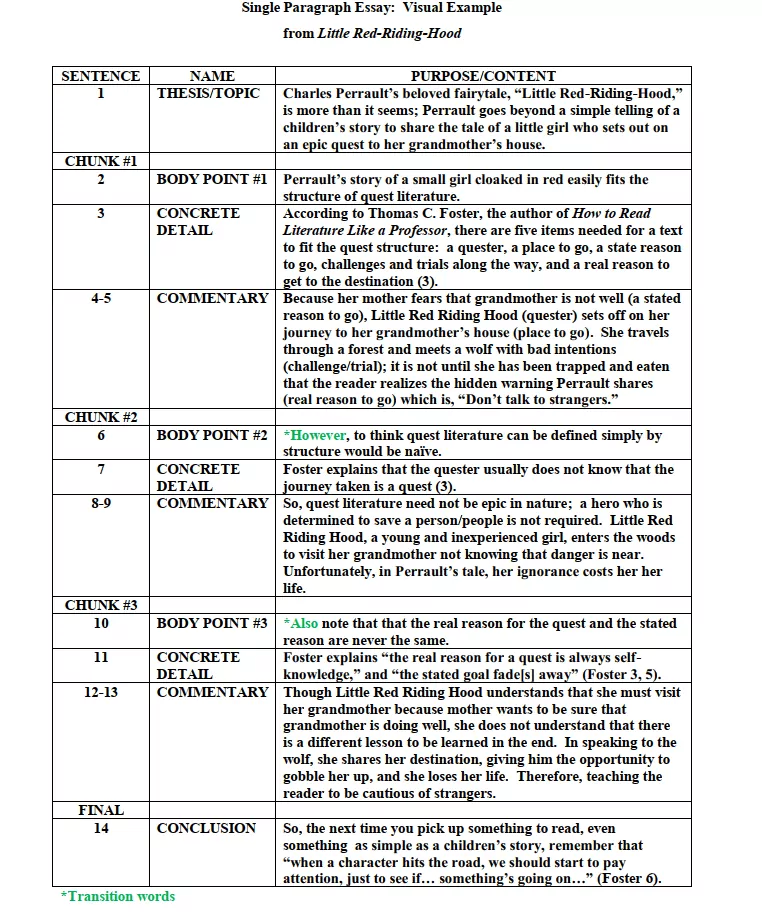
Formatting a Single-Paragraph Essay
In terms of formatting, a one-paragraph essay should be double-spaced or single-spaced, with no spaces between the title and the paragraph, a one-inch margin, a 12-point font size, and Times New Roman or Arial.
Essays written in one paragraph include narrative essays, college essays, profile essays, first-person essays, leadership, personal philosophy essays, definition essays, and short critical, analytical, expository, and literary analysis essays.
One-paragraph essay is comprehensive and a condensed version of the full academic essay. They focus on one idea like a typical paragraph and have in-text citations. You should use transitions when writing the essays and ensure they are structured well.
Single-paragraph essays have the advantage of being easy to write, read, and grade. Besides, they can be used to explain different concepts in a snapshot.
Final Words
Nothing is cast in stone regarding the number of paragraphs an essay can have. Can an essay be one paragraph? Yes, it can be an independent paragraph and falls under the short essay category. It is a suitable approach for short-answer essay-based exam questions.
As a short essay, 100-300 words long, a one-page essay contains one main idea. So, you can write one paragraph for an essay and get the grades if you meet the requirements in the essay prompt or the rubric.
It should be 10-14 sentences long, depending on the number of body points (BPs), condensed details (CDs), and the Commentaries. A long one-paragraph essay can be between 200 and 225 words long.
If you need help with writing a one-paragraph essay, we have handpicked essay writers who can geek your essay within a few hours.
Need a Discount to Order?
15% off first order, what you get from us.

Plagiarism-free papers
Our papers are 100% original and unique to pass online plagiarism checkers.

Well-researched academic papers
Even when we say essays for sale, they meet academic writing conventions.

24/7 online support
Hit us up on live chat or Messenger for continuous help with your essays.

Easy communication with writers
Order essays and begin communicating with your writer directly and anonymously.
Learning Materials
- Business Studies
- Combined Science
- Computer Science
- Engineering
- English Literature
- Environmental Science
- Human Geography
- Macroeconomics
- Microeconomics
- Single Paragraph Essay
An essay is defined as a short piece of writing on a particular subject, but is it possible for an essay to be just one paragraph? In short, yes! It is possible to condense the essence of the traditional, multi-paragraph essay format into a single-paragraph essay.
Millions of flashcards designed to help you ace your studies
- Cell Biology
Which of the following is not a concern for single-paragraph essay format?
True or false: You can use any rhetorical strategy in single-paragraph essays.
Which of the following is not an example of concrete details for body support?
True or false: In a single-paragraph essay, you should include a short commentary on the interplay between thesis and support.
True or false: Because of how short a single-paragraph essay must be, the main goal is to develop and support the main idea, using whatever means, as thoroughly and concisely as possible.
Single-paragraph essays can be used as a format for __________ responses on exams.
True or false: All paragraphs must stay within the 4-5 sentence range.
Because of the length of a single-paragraph essay, it is important to state your main point _____________
_________ offer(s) more specific information about the main idea.
Which of the following is not something recommended to support the main idea?
The following is an example of which type of support?The supreme court was founded on March 4, 1789.
Need help? Meet our AI Assistant

Need help with Single Paragraph Essay? Ask our AI Assistant

Review generated flashcards
to start learning or create your own AI flashcards
Start learning or create your own AI flashcards

StudySmarter Editorial Team
Team Single Paragraph Essay Teachers
- 11 minutes reading time
- Checked by StudySmarter Editorial Team
- 5 Paragraph Essay
- Argumentative Essay
- Creative Writing
- Cues and Conventions
- English Grammar
- English Language Study
- Essay Prompts
- Essay Writing Skills
- Global English
- History of English Language
- International English
- Key Concepts in Language and Linguistics
- Language Acquisition
- Language Analysis
- Language and Social Groups
- Lexis and Semantics
- Linguistic Terms
- Listening and Speaking
- Multiple Choice Questions
- Research and Composition
- Rhetorical Analysis Essay
- Main Idea and Supporting Detail
- Statistical Evidence
- Sociolinguistics
- Summary Text
- Synthesis Essay
- TESOL (English)
- Textual Analysis
Jump to a key chapter
Meaning of Single Paragraph Essay
The foundation of any essay is made up of the main idea , information that supports the main idea with commentary, and a conclusion. In a standard five-paragraph essay, these elements are typically given the space of at least a single paragraph for each.
A single-paragraph essay is a condensed version of a traditional essay that includes the main idea , supporting details, and conclusion in the space of one paragraph. Just like a standard essay, single-paragraph essays convey the author's message through the use of rhetorical strategies (which we'll look at in more detail later in the explanation) and literary devices .
Literary device: a way of using language that goes beyond the literal meaning of the words.
Similes, metaphors, personification, symbolism, and imagery are common literary devices. These devices are creative writing tools that are effective in any context , including a single-paragraph essay, for the purpose of enhancing communication.
Because of how short a single-paragraph essay must be, the main goal is to develop and support the main idea, using whatever means, as thoroughly and concisely as possible.
Why Would You Write a Single Paragraph Essay?
There are a few reasons you might need to write a single-paragraph essay. The first reason is that many exams include "short answer" responses, sometimes representing a hefty percentage of your overall score, which are essentially single-paragraph essays.
Single-paragraph essays are also a great exercise in concise writing. If you're only given a few sentences to make a point and support it well, then you'll have to practice "trimming the fat" from your writing or removing anything that is not essential to your purpose. This is also an essential skill for writing even longer-format essays.
Top tip: Keeping your paragraph to the widely-taught 4–5 sentence structure is a good rule of thumb for an average essay, but it is not always necessary. A paragraph can extend to as long as 8-10 sentences or more and still be a paragraph.
Tips for Writing a Single Paragraph Essay
Writing a single-paragraph essay can actually be more of a challenge than a several-page paper. Because of the space constraints, it is absolutely essential to make your point in a concise manner without sacrificing the message. This means leaving out filler language and any parts of the discussion that are not essential to making your point clear.
One technique for writing a single-paragraph essay is to write a longer essay and narrow it down to one paragraph. If you are writing a short answer response in an exam, this wouldn't be an ideal approach due to the time constraints. If time isn't an issue, though, then then this strategy could help you to make sure you include only the most important aspects of a discussion in your one paragraph.
Try the "necessity test" to narrow down your writing. This is the process of eliminating one sentence at a time and seeing if the author's point has been weakened. If it has, then you need to keep that sentence, but if it hasn't, then you can proceed until only the essential parts of the discussion remain.
Another technique is to write down a short list of the ideas you want to get across with your single-paragraph essay. Once you've written down everything you believe is relevant to the discussion, go through your list and look for anything that can be combined or condensed in any way.
If you find you're still having trouble condensing your discussion, then you might consider simplifying your main point. It's possible that you have too many supporting points, so perhaps pick the top two most effective ones and stop there.

Types of Single Paragraph Essay
As with a traditional essay, single-paragraph essays can be used to discuss any topic the writer has some knowledge about. This also means that single-paragraph essays can use any rhetorical strategy to make their point.
Rhetorical strategies : also known as rhetorical modes, rhetorical strategies are ways of organizing communication so that it has the greatest effect on the listener or reader. These are specific patterns of organization to achieve the writer's goal for any text.
Some of the more common rhetorical strategies are:
- Comparison/contrast
- Illustration
- Description
- Classification
Essays can be assigned based on a particular rhetorical strategy.
Sometimes, an essay prompt, such as "Write a comparison/contrast essay analyzing the relationship between organic and non-organic produce production," may make it clear which rhetorical strategy should be used to answer the question.
Other times, the author simply needs to understand these strategies well enough to know which to use in order to craft the best argument.
So, in essence, any discussion in a multi-paragraph essay could also be covered in a single-paragraph essay. The only limitation of a shorter essay is, of course, the lack of space, so the writer has to make the best use of the paragraph they have.
Single Paragraph Essay Structure
An essay is a focused piece of writing that develops a particular idea through the use of evidence , analysis, and interpretation. Nowhere in that definition do we see any description of length, which means this could be accomplished over the course of several pages or a single paragraph.
Unlike traditional essays, though, single-paragraph essays don't allow for much creative liberty. There is a basic structure that needs to be followed so that the paragraph will meet the criteria of an essay.
Here is a basic single-paragraph essay outline :
Topic sentence ( thesis statement )
Body support 1
Concrete details
Body support 2
Closing statement

Topic Sentence in a Single Paragraph Essay
Every essay has a thesis statement .
Thesis statement: a single, declarative sentence that summarizes the main point of an essay. Depending on the style of the essay, a thesis statement should almost always include the author's stance on the topic of discussion.
In a single-paragraph essay, the thesis statement acts a lot like a topic sentence of a supporting body paragraph found in a traditional five-paragraph essay. Typically, the first sentence in a body paragraph – the topic sentence – helps to organize the paragraph around the main idea that will be discussed. Since the essay will only be one paragraph long, the thesis statement and topic sentence are one and the same.
Use the thesis statement to introduce the topic as well as the main idea you will be discussing. It is also helpful to briefly mention the supporting points you intend to bring in later in the paragraph.
Thesis statement: The British Empire's ability to wreak havoc on trade, move large amounts of troops, and distribute resources by way of its navy gave them the power to dominate foreign territories.
This is a good thesis statement because the writer shares their opinion on what made the British empire powerful. There are three pieces of evidence to show Britain's power (ability to wreak havoc on trade, move large amounts of troops, and distribute resources) which can be developed in the body of the essay.
Body Support in a Single Paragraph Essay
The body of the essay is where the writer develops concrete details to support the thesis statement. Supporting details can be anything that helps prove your point.
Supporting details could include:
- Statistical evidence and data.
- Quotes from the discussed text or relevant experts in the field.
- Examples of facts that support the thesis.
- Details about events, people, or places that are relevant to the topic.
In a single-paragraph essay, there isn't as much space as you're perhaps used to, so you must be concise and direct when presenting your support. There won't be much opportunity to expound and explain each detail, so make sure they can stand alone in support of your thesis.
Also, include a brief commentary on the subject. This is your opportunity to connect your main idea or thesis to the supporting details and discuss how they interact.
Conclusion in a Single Paragraph Essay
As with the body support, your conclusion should be brief (likely no more than a sentence or two). Because you've conducted your discussion in the space of one paragraph, it is not necessary to restate your thesis in the conclusion as you would normally do in a multi-paragraph essay.
You should make sure that your conclusion is clear and convinces the reader that you did indeed make your point. Include a short summary of the discussion, and that's about all you'll have room for!
If you find your essay is longer than one paragraph, read through it one sentence at a time to see if every sentence contributes a different point. If you come across two sentences that are making the same or similar points, combine them into one sentence.
Single Paragraph Essay Example
Here is an example of a single-paragraph essay outline , including the topic sentence , body support 1 , body support 2 , and the conclusion .
Topic sentence
Charles Perrault's famous fairytale, "Little Red Ridinghood" (1697), is more than meets the eye. It is not just a story about a little girl who visits her grandma; it is an epic tale complete with a journey, villain, and challenges along the way for the protagonist.
"Little Red Ridinghood" is structured like a piece of quest literature. There is a quester, a place to go, a stated reason to go, challenges and trials along the way, and a real reason to arrive at the destination. Little Red Ridinghood (quester) decides to visit her grandma because she believes she is not well (reason to go). She travels through a wood and meets a wolf with bad intentions (villain/challenge). After she is eaten by the wolf, the reader comes to know the moral of the story (real reason to go), which is "don't talk to strangers."
Quest literature is not simply defined by structure, however. In quest literature, the hero usually does not know that the journey taken is a quest. So, the journey does not need to be epic in nature, and a hero is not required to save lives and fight battles – a young girl entering the woods not knowing that danger lurks around the corner is quest enough.
So the next time you pick up a book, remember that even a bedtime story for children can hold inside an epic quest – just look for someone leaving on a journey, and you might be surprised where it takes you.
Single Paragraph Essay - Key takeaways
- A single-paragraph essay is a condensed version of a traditional essay that includes the main idea, supporting details, and a conclusion in the space of one paragraph.
Due to limited space, it is important to stick to facts and evidence alone, leaving out filler language.
A single-paragraph essay does require a thesis or main idea, but it only needs to be stated once.
There are several techniques to keeping your writing brief, such as the "necessity test" and/or making a list of your ideas and choosing the most relevant information.
A single-paragraph essay is a good format for "short answer" responses on exams.
Flashcards in Single Paragraph Essay 68
Rhetorical strategy
Literary devices
Short answer

Learn with 68 Single Paragraph Essay flashcards in the free StudySmarter app
We have 14,000 flashcards about Dynamic Landscapes.
Already have an account? Log in
Frequently Asked Questions about Single Paragraph Essay
What is a single-paragraph essay?
A single-paragraph essay is a condensed version of a traditional essay that includes a main idea, supporting details, and a conclusion in the space of one paragraph.
What is an example of single-paragraph essay?
A single-paragraph essay can be a response to a "short answer" question on an exam.
How do you write a single-paragraph essay?
Write a single-paragraph essay by focusing on your main point and the supporting details. Avoid filler language, and try techniques such as the "necessity test" and writing down your ideas and choosing the most relevant information to keep it to the one-paragraph format.
What are the types of single paragraph essay?
Single-paragraph essays can be in the style of any type of "regular" essay.
How to organize a single paragraph essay?
Organize a single-paragraph essay in the same format as a traditional essay with a thesis statement, supporting details, and a conclusion.
Test your knowledge with multiple choice flashcards

Join the StudySmarter App and learn efficiently with millions of flashcards and more!
That was a fantastic start, you can do better, sign up to create your own flashcards.
Access over 700 million learning materials
Study more efficiently with flashcards
Get better grades with AI
Already have an account? Log in
Keep learning, you are doing great.
Discover learning materials with the free StudySmarter app

About StudySmarter
StudySmarter is a globally recognized educational technology company, offering a holistic learning platform designed for students of all ages and educational levels. Our platform provides learning support for a wide range of subjects, including STEM, Social Sciences, and Languages and also helps students to successfully master various tests and exams worldwide, such as GCSE, A Level, SAT, ACT, Abitur, and more. We offer an extensive library of learning materials, including interactive flashcards, comprehensive textbook solutions, and detailed explanations. The cutting-edge technology and tools we provide help students create their own learning materials. StudySmarter’s content is not only expert-verified but also regularly updated to ensure accuracy and relevance.
Team English Teachers
Study anywhere. Anytime.Across all devices.
Create a free account to save this explanation..
Save explanations to your personalised space and access them anytime, anywhere!
By signing up, you agree to the Terms and Conditions and the Privacy Policy of StudySmarter.
Sign up to highlight and take notes. It’s 100% free.
Join over 22 million students in learning with our StudySmarter App
The first learning app that truly has everything you need to ace your exams in one place
- Flashcards & Quizzes
- AI Study Assistant
- Study Planner
- Smart Note-Taking


AI Generator
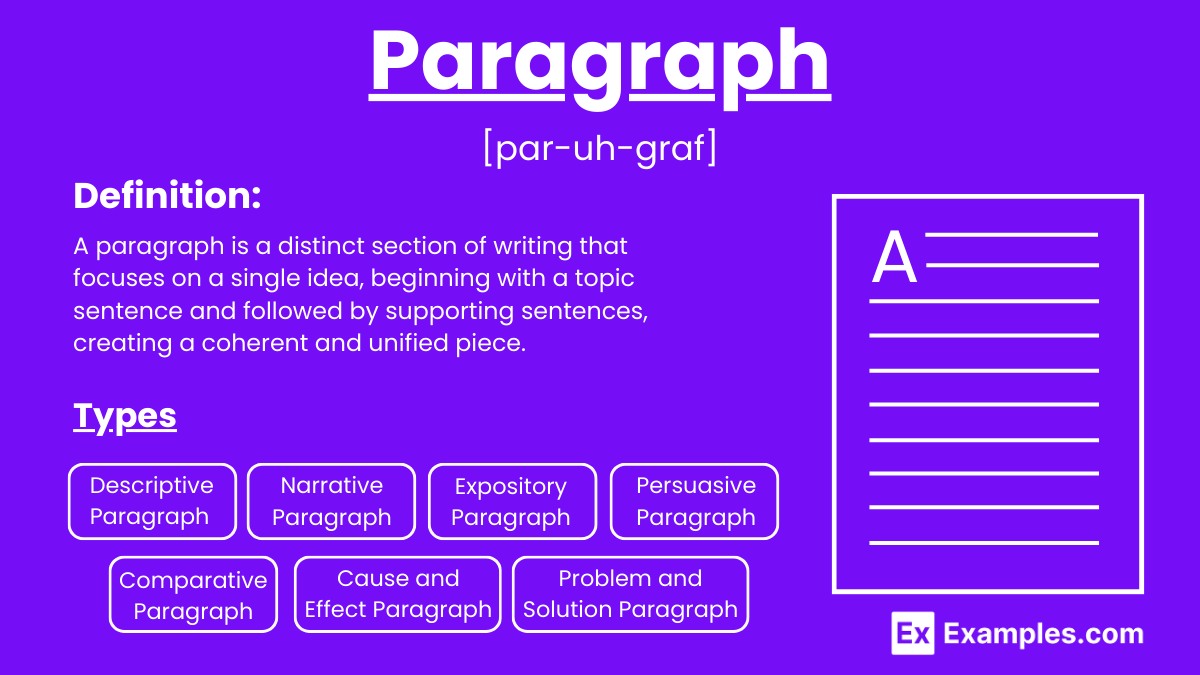
A paragraph is a fundamental unit of writing that focuses on a single idea or topic. It typically consists of a topic sentence , supporting sentences, and a concluding sentence . The topic sentence introduces the main idea, while the supporting sentences provide details, examples, or explanations. The concluding sentence summarizes the main point or transitions to the next paragraph. Effective paragraphs enhance the clarity and coherence of writing, making it easier for readers to understand and engage with the content. Whether in essays, articles, or reports, well-structured paragraphs are essential for effective communication .
Check Out Free Paragraph Writer Tool
What Is a Paragraph?
A paragraph is a distinct section of writing that deals with a specific point or idea, typically consisting of several sentences. It begins with a topic sentence that introduces the main idea, followed by supporting sentences that develop this idea through details, examples, and explanations. A concluding sentence may be included to summarize the main point or provide a transition to the next paragraph. Paragraphs help organize writing, making it easier to read and understand by breaking the text into manageable sections.
Paragraph Format
1. topic sentence.
Start with a topic sentence that introduces the main idea of the paragraph. It tells the reader what the paragraph will be about.
Example: “Regular exercise is essential for maintaining good health.”
2. Supporting Sentences
Add 3-5 sentences that provide details, examples, or explanations supporting the main idea. These sentences should connect logically and build on the topic sentence.
Example: “Exercise helps control weight, reduce the risk of chronic diseases, and improve mental health. Physical activities like walking, running, and swimming increase cardiovascular fitness. Regular exercise releases endorphins, which are natural mood lifters. It also helps improve sleep quality and boosts energy levels.”
3. Transitions
Use transition words to connect your sentences and make the paragraph flow smoothly. Examples of transition words include “furthermore,” “in addition,” “moreover,” “however,” and “therefore.”
Example: “Moreover, regular exercise releases endorphins, which are natural mood lifters.”
4. Concluding Sentence
Finish with a concluding sentence that wraps up the main idea and reinforces what you’ve discussed.
Example: “Therefore, incorporating regular exercise into your daily routine is vital for a healthy and balanced life.”
Example of a Well-Formatted Paragraph
Regular exercise is essential for maintaining good health. Exercise helps control weight, reduce the risk of chronic diseases, and improve mental health. Physical activities like walking, running, and swimming increase cardiovascular fitness. Moreover, regular exercise releases endorphins, which are natural mood lifters. Additionally, it helps improve sleep quality and boosts energy levels. Therefore, incorporating regular exercise into your daily routine is vital for a healthy and balanced life.
What is the Best Example of Paragraph
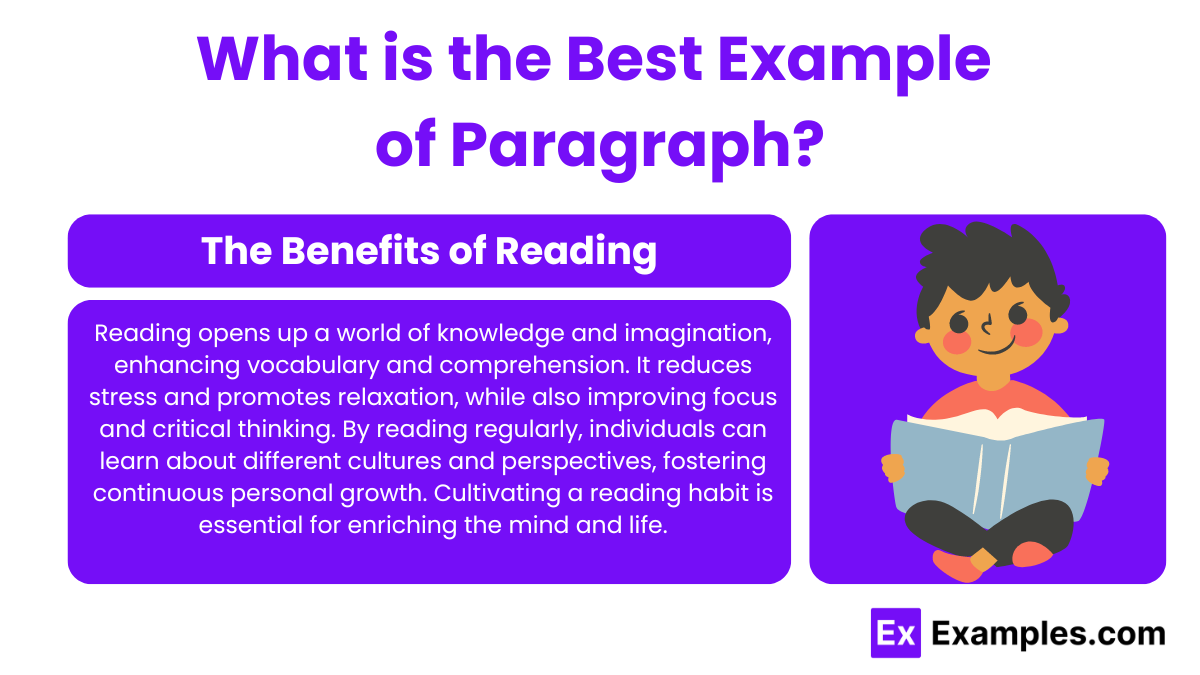
The Importance of Reading
Reading is a fundamental skill that significantly impacts personal and academic growth. It enhances vocabulary, improves comprehension, and fosters critical thinking. When individuals read regularly, they are exposed to new ideas and perspectives, which broadens their understanding of the world. Additionally, reading stimulates the brain, keeping it active and engaged, which can help prevent cognitive decline. It also provides a means of relaxation and stress reduction, as immersing oneself in a good book can be a soothing escape from daily pressures. Therefore, cultivating a habit of reading not only contributes to intellectual development but also promotes overall well-being.
Paragraph Examples
Example 1: benefits of regular exercise.
Regular exercise offers numerous benefits, both physically and mentally. Engaging in physical activities like jogging, swimming, or cycling helps improve cardiovascular health, strengthen muscles, and enhance flexibility. Exercise also plays a crucial role in weight management and reducing the risk of chronic diseases such as diabetes and hypertension. Moreover, regular physical activity is known to boost mental health by alleviating symptoms of depression and anxiety, promoting better sleep, and enhancing overall mood. By making exercise a part of your daily routine, you can significantly improve your quality of life and longevity.

Example 2: Importance of Time Management
Effective time management is essential for achieving success and maintaining a balanced life. By prioritizing tasks and setting clear goals, individuals can maximize productivity and reduce stress. Time management involves creating schedules, setting deadlines, and avoiding procrastination. It also requires the ability to delegate tasks when necessary and to focus on one task at a time. Proper time management not only helps in completing tasks efficiently but also allows for more free time to relax and pursue personal interests. Developing good time management skills is key to achieving both professional and personal goals.
Example 3: The Impact of Social Media on Society
Social media has revolutionized the way we communicate and interact with one another. Platforms like Facebook, Twitter, and Instagram have made it easier to stay connected with friends and family, share information, and express opinions. However, social media also has its downsides. It can lead to issues such as cyberbullying, privacy concerns, and the spread of misinformation. Additionally, excessive use of social media can contribute to mental health problems like anxiety and depression. It is important for users to be mindful of their social media habits and strive for a healthy balance between online and offline interactions.
Example 4: The Importance of Environmental Conservation
Environmental conservation is crucial for the health and sustainability of our planet. Protecting natural habitats, preserving biodiversity, and reducing pollution are essential steps in maintaining the balance of ecosystems. Conservation efforts help ensure clean air and water, fertile soil, and a stable climate. Individuals can contribute to environmental conservation by adopting eco-friendly practices such as recycling, reducing energy consumption, and supporting sustainable products. Governments and organizations also play a vital role by implementing policies and initiatives aimed at protecting the environment. By working together, we can safeguard our planet for future generations.
Example 5: The Role of Technology in Education
Technology has transformed the field of education, making learning more accessible and engaging. Online courses, interactive learning platforms, and educational apps provide students with a wealth of resources at their fingertips. Technology enables personalized learning, allowing students to learn at their own pace and according to their individual needs. It also facilitates collaboration and communication among students and teachers, enhancing the overall learning experience. However, it is important to use technology responsibly and ensure that it complements traditional teaching methods. By integrating technology effectively, we can create a more dynamic and inclusive educational environment.
Short Paragraph Examples
Paragraph on value of time.
Time is an invaluable resource, one that we cannot reclaim once it’s lost. Every moment holds the potential for growth, learning, and creating meaningful experiences. Time management enables us to maximize our productivity and achieve our goals efficiently. By valuing time, we make conscious decisions about how we spend it, prioritizing tasks that align with our long-term aspirations. Understanding the worth of time fosters discipline, reduces stress, and enhances our overall well-being. In essence, appreciating time empowers us to live a more purposeful and fulfilling life.
- paragraph on internet
- paragraph on drug addiction
- paragraph on climate change
- paragraph on food adulteration
- paragraph on air pollution
- paragraph on environment
- paragraph on save water
- paragraph on water
- paragraph on books are our best friends
- paragraph on nature
- paragraph on hard work
- paragraph on health
- paragraph on games and sports
- paragraph on technology
- paragraph on social media
- paragraph on success
- paragraph on work is worship
- paragraph on disaster management
- paragraph on laughter is the best medicine
- paragraph on noise pollution
- paragraph on kindness
- paragraph on rainwater harvesting
- paragraph on desert
Paragraph Examples for Students
- paragraph on discipline
- paragraph on my aim in life
- paragraph on importance of education
- paragraph on early rising
- paragraph on daily routine
- paragraph on morning walk
- paragraph on newspaper
- paragraph on if i were a bird
- paragraph about football
- paragraph on a visit to a zoo
- paragraph on a visit to a hill station
- paragraph on grandparents
- paragraph on morning assembly in my school
- paragraph on a house on fire
Paragraph Examples for Middle School
- paragraph on my favourite teacher
- paragraph on winter morning
- paragraph on my place
- paragraph on my house
- paragraph on summer vacation
- paragraph on christmas
- paragraph on an ideal student
- paragraph writing on covid 19
- paragraph on mother teresa
- paragraph on elephant
- paragraph on computer
- paragraph on flood
- paragraph on gandhi jayanti
- paragraph on festival
- paragraph on doctor
- paragraph on solar system
- paragraph on red fort
- paragraph on earth day
- paragraph on plants
- paragraph on sikkim
- paragraph on unsung heroes of freedom struggle
- paragraph on tsunami
Paragraph Examples for High School
- paragraph on mobile phone
- paragraph on artificial intelligence
- paragraph on early to bed
- paragraph on our national flag
- paragraph on road accident
- paragraph on online classes
- paragraph on lion
- paragraph on forest
- paragraph on earth
Paragraph Examples for Kids
- paragraph on my mother
- paragraph on my sister
- paragraph on my father
- paragraph on my brother
- paragraph on myself
- paragraph on my school
- paragraph on my grandmother
- paragraph on parrot
- paragraph on badminton
Paragraph Examples for 2nd Grade
- paragraph on raksha bandhan
- paragraph on janmashtami
- Paragraph on My Pet
- Paragraph on My Best Friend
- Paragraph on My Favorite Toy
Paragraph Examples for 3rd Grade
- paragraph on my family
- paragraph on my hobby
- Paragraph on My Favorite Game
- Paragraph on A Trip to the Park
Paragraph Examples for 4th Grade
- paragraph on dengue fever
- Paragraph on My Favorite Season
- Paragraph on A Day at the Beach
Paragraph Examples for 5th Grade
- Paragraph on The Importance of Sharing
- Paragraph on My Favorite Animal
Paragraph Examples for Grade 6
- paragraph on a rainy day
- Paragraph on A Memorable Birthday
- Paragraph on A Visit to a Museum
Paragraph Examples for Grade 7
- paragraph on rainy season
- Paragraph on The Importance of Teamwork
- Paragraph on A School Event
Paragraph Examples for Grade 8
- Paragraph on A Historical Figure I Admire
- Paragraph on The Impact of Technology on Education
Paragraph Examples for Grade 9
- Paragraph on The Role of Social Media in Our Lives
- Paragraph on The Benefits of Reading
Paragraph Examples for Grade 10
- Paragraph on The Importance of Healthy Eating
- Paragraph on The Effects of Global Warming
Paragraph Examples for Grade 11
- Paragraph on The Influence of Music on Culture
- Paragraph on The Benefits of Learning a Second Language
Paragraph Examples for Grade 12
- Paragraph on Preparing for College
- Paragraph on The Importance of Time Management
Paragraph Examples College Students
- Paragraph on The Benefits of Internships
- Paragraph on Balancing Work and Study
Narrative Paragraph Examples
- happy birthday paragraph
- paragraph for her
- paragraph for him
- Paragraph Transitions
Types of Paragraphs
Understanding the different types of paragraphs can help enhance your writing by using the most effective structure for each part of your text. Here are the main types of paragraphs:
1. Descriptive Paragraph
A descriptive paragraph paints a vivid picture of a person, place, thing, or idea using detailed observations and sensory descriptions. It focuses on creating an immersive experience for the reader, helping them visualize and experience the subject through words.
2. Narrative Paragraph
A narrative paragraph tells a story or recounts events in a chronological order. It includes characters, a setting, and a plot, guiding the reader through the sequence of events. This type of paragraph aims to engage and entertain the reader with a clear storyline.
3. Expository Paragraph
An expository paragraph aims to explain, inform, or clarify a topic. It presents facts, definitions, and explanations in a logical and straightforward manner. The goal is to provide the reader with a clear understanding of the subject, using evidence and examples to support the information.
4. Persuasive Paragraph
A persuasive paragraph seeks to convince the reader of a particular viewpoint or argument. It presents reasons, evidence, and examples to support the writer’s position. The goal is to persuade the reader to agree with the writer’s perspective through logical reasoning and emotional appeal.
5. Comparative Paragraph
A comparative paragraph compares and contrasts two or more items, ideas, or concepts. It highlights similarities and differences, helping the reader understand the relative characteristics of each subject. This type of paragraph often uses transitional words to clearly indicate comparisons and contrasts.
6. Cause and Effect Paragraph
A cause and effect paragraph explains the reasons why something happened (cause) and the results that followed (effect). It analyzes the relationship between events, helping the reader understand the sequence and consequences. This type of paragraph often explores multiple causes and their effects.
7. Problem and Solution Paragraph
A problem and solution paragraph identifies a specific problem and proposes one or more solutions. It describes the issue in detail, explains its significance, and then offers practical and feasible solutions. The goal is to address the problem effectively and persuade the reader of the proposed solutions’ viability.
5-Paragraph Essay Template

4 Paragraph Cover Letter Format

Introduction Paragraph Format
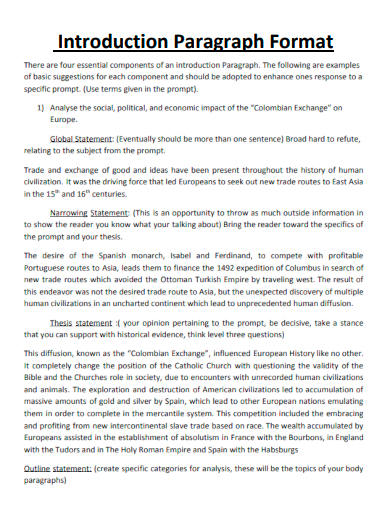
Basic Paragraph Format
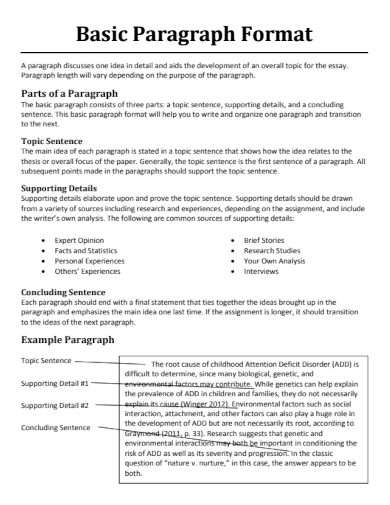
Organization Paragraph Format

Paragraph and Page Formatting

Essay and Paragraph Format
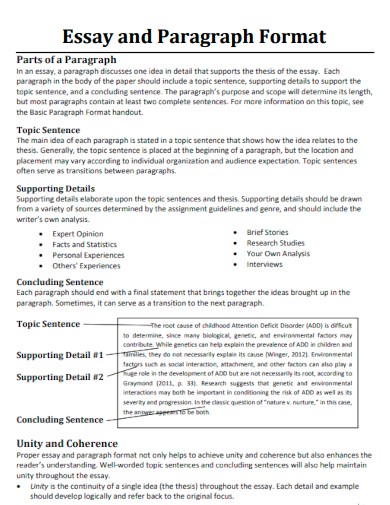
Paragraph & Line Spacing Format
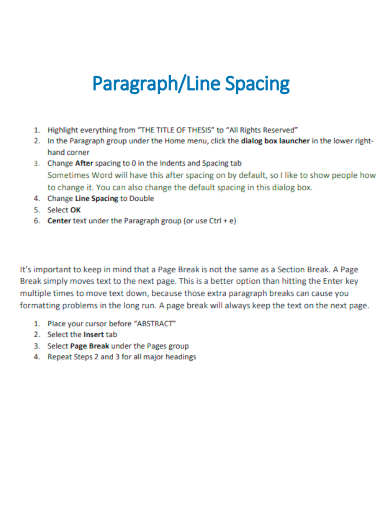
Body Paragraph Structure and Development
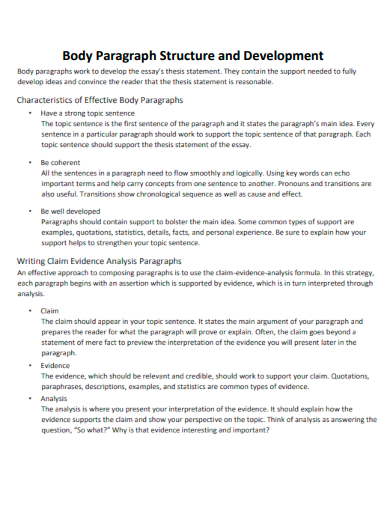
Chunked Paragraph Format

Dos and Don’ts of Paragraph
Paragraph is crucial for clear and impactful communication. A well-structured paragraph helps convey your ideas logically and keeps the reader engaged. Here are some key dos and don’ts to keep in mind when crafting a paragraph.
How to Format/Write a Perfect Paragraph?
Before diving into the depths of paragraph formatting, it’s essential to recognize that the specific requirements may vary depending on the intended format of your writing. Whether you’re composing an email, working on a book, designing an outline format, or crafting a one-pager , understanding the purpose and context of your writing will guide your paragraph formatting decisions.
Step 1: Determine the Context:
Before delving into paragraph formatting, understand the context and purpose of your writing. Consider whether you’re writing an email, a book, an outline format, a one-pager, or an informative essay outline. Each format may have specific formatting requirements.
Step 2: Indentation:
Indentation plays a crucial role in paragraph formatting. For most formats, including books and essays, indent the first line of each paragraph. This indentation visually separates paragraphs and aids in readability. Use the tab key or the ruler in your word processing software to apply consistent indentation.
Step 3: Alignment
Ensure your paragraphs are aligned consistently throughout your writing. The most common alignment is left-aligned, where the left margin of each line is straight. Avoid center-aligning or right-aligning paragraphs unless the format specifically calls for it.
Step 4: Spacing
Consider the spacing between paragraphs to enhance readability. In some formats, such as emails or one-pagers, it’s beneficial to include blank lines or line breaks between paragraphs to create visual separation. However, in other formats like books or essays, single spacing without additional blank lines is typically preferred.
Step 5: Coherence and Unity
Maintain coherence and unity within each paragraph. A well-formatted paragraph should contain a clear topic sentence or main idea, followed by supporting sentences that expand on the main idea. Ensure there is a logical flow between sentences, guiding readers through your thoughts smoothly.
Step 6: Length and Consistency
Keep your paragraphs concise and focused. Long paragraphs can be overwhelming for readers, while short paragraphs can disrupt the flow of ideas. Aim for a balanced length and strive for consistency throughout your writing.
Is a paragraph 3 or 5 sentences?
A paragraph typically consists of 3 to 5 sentences. This range allows for a clear and concise expression of ideas, ensuring that each paragraph contains a complete thought or topic. While some paragraphs may extend beyond five sentences, especially in more complex writing, 3 to 5 sentences is a standard guideline.
How long is a paragraph?
A paragraph usually ranges from 100 to 200 words. This length allows for sufficient development of ideas while maintaining readability. Longer paragraphs may be appropriate in academic or detailed writing, but in general, keeping paragraphs within this word range ensures that the text remains accessible and engaging for readers.
Can a paragraph be 300 words?
Yes, a paragraph can be 300 words if it is well-structured and coherent. Longer paragraphs are often found in academic or technical writing where detailed explanations are necessary. However, for most writing, shorter paragraphs are preferred as they are easier to read and help maintain the reader’s interest and engagement.
Is a 150-word paragraph too short?
No, a 150-word paragraph is not too short; it is within the typical length range. Concise paragraphs can be very effective in conveying clear and focused ideas. In fact, shorter paragraphs are often used in digital content and journalism to enhance readability and ensure that key points are communicated efficiently.
In conclusion, maintaining a well-organized approach to tasks enhances productivity and efficiency. By prioritizing activities and managing time effectively, individuals can achieve their goals more successfully. Developing a disciplined routine fosters personal growth, reduces stress, and ensures steady progress in both professional and personal endeavors, leading to overall satisfaction and fulfillment.
Text prompt
- Instructive
- Professional
10 Examples of Public speaking
20 Examples of Gas lighting

IMAGES
VIDEO
COMMENTS
A one-paragraph essay, also known as a single-paragraph essay or the chunk paragraph, is a concise and boiled-down version of a full academic essay. It comprises a formal thesis statement at the beginning, concrete details and …
Whether it’s a supplemental essay, personal statement, Common App essay, or diversity essay, the essays below can help you better understand what can result from following a college essay format or applying tips for how …
writing a single paragraph essay, leave out the general information used to set up your thesis in the introduction and leave out the re-thesis and implications normally used in a concluding …
Single Paragraph Essay Example. Here is an example of a single-paragraph essay outline, including the topic sentence, body support 1, body support 2, and the conclusion.
A good introduction paragraph is an essential part of any academic essay. It sets up your argument and tells the reader what to expect. The main goals of an introduction are to: …
Paragraph Format. 1. Topic Sentence. Start with a topic sentence that introduces the main idea of the paragraph. It tells the reader what the paragraph will be about. Example: “Regular exercise is essential for …
A single-paragraph essay consists of a formal thesis statement at the beginning and a closing statement at the conclusion. Leave out the broad material needed to build up your thesis in the introduction, as well as the re-thesis and …